Physics Exam > Physics Notes > Electricity & Magnetism > Capacitive Circuits
Capacitive Circuits | Electricity & Magnetism - Physics PDF Download
Capacitance
Electrically, capacitance is the ability to store an electric charge. Capacitance is equal to the amount of charge that can be stored in a capacitor divided by the voltage applied across the plates
C = Q/V
where C = capacitance, F; Q = amount of charge, C; V = voltage, V Above equation can be rewritten as follows: Q = CV or V = Q/C.
The unit of capacitance is the farad (F). The farad is that capacitance that will store one coulomb of charge in the dielectric when the voltage applied across the capacitor terminals is one volt.
- Capacitive Reactance
Capacitive reactance XC is the opposition to the flow of ac current due to the capacitance in the circuit. The unit of capacitive reactance is the ohm. Capacitive reactance can be found by using the equation
where XC = capacitive reactance, Ω ; f = frequency, Hz; C = capacitance, F If any two quantities are known, the third can be found
Voltage and current in a circuit containing only capacitive reactance can be found using Ohm’s law. However, in the case of a capacitive circuit, R is replaced by XC.
where IC = current through the capacitor A; VC = voltage across the capacitor, V XC = capacitive reactance, Ω - Capacitors in Series or Parallel
When capacitors are connected in series (as shown in figure below) the total capacitance CT is
The total capacitance of two capacitors in series is
When n number of series capacitors have the same capacitance, CT = C/n. Capacitances in seriesWhen capacitors are connected in parallel (as shown in figure below), the total capacitance CT is the sum of the individual capacitances.
Capacitances in seriesWhen capacitors are connected in parallel (as shown in figure below), the total capacitance CT is the sum of the individual capacitances.
Parallel: CT = C1 + C2 + C3 +... + Cn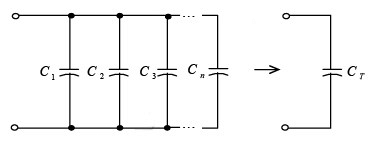 Capacitances in parallel
Capacitances in parallel - Capacitive Circuits
➤ Capacitance Only
If an ac voltage v is applied across a circuit having only capacitance (figure a), the resulting ac current through the capacitance ic, will lead the voltage across the capacitance, vC , by 90° (figure b and c), (Quantities expressed as lowercase letters, ic and , vC indicate instantaneous values.) Voltages v and vC are the same because they are parallel. Both ic and vC are sine waves with the same frequency. In series circuits, the current IC is the horizontal phasor for reference (figure d) so the voltage VC can be considered to lag IC by 90°.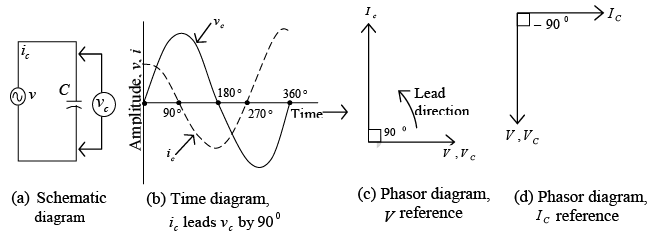 Circuit with C only
Circuit with C only
➤ RC in Series
As with inductive circuits, the combination of resistance and capacitive reactance (figure a shown below) is called impedance. In a series circuit containing R and XC, the same current I flows in XC and R. The voltage drop across R is VR = IR, and the voltage drop across XC is VC = IXC . The voltage across XC lags the current through XC by 90° (figure b shown below). The voltage across R is in phase with I since resistance does not produce a phase shift.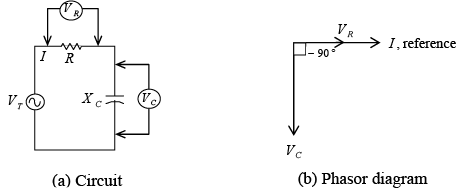 R and XC in seriesTo find the total voltage VT , we add phasors VR and VC . Since they form a right triangle (as shown in figure below),
R and XC in seriesTo find the total voltage VT , we add phasors VR and VC . Since they form a right triangle (as shown in figure below), 
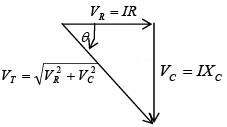 Voltage-triangle phasorNote that the IX C phasor is downward, exactly opposite from an IXL phasor, because of the opposite phase angle.
Voltage-triangle phasorNote that the IX C phasor is downward, exactly opposite from an IXL phasor, because of the opposite phase angle.
The phase angle θ between VT and VR is expressed according to the following equation:
➤ Impedance in Series RC
The voltage triangle corresponds to the impedance triangle because the common factor I in VC and VR cancels. Series RC impedance triangleImpedance Z is equal to the phasor sum of R and XC
Series RC impedance triangleImpedance Z is equal to the phasor sum of R and XC  The phase angle θ is
The phase angle θ is
➤ RC in Parallel
In the RC parallel circuit (figure a shown below), the voltage is the same across the source, R, and XC since they are all in parallel. Each branch has its individual current. The resistive branch current IR = VT / R is in phase with VT. The capacitive branch current IC = VT /XC leads VT by 90° (figure b shown below). The phasor diagram has the source voltage VT as the reference phasor because it is the same throughout the circuit. The total line current IT equals the phasor sum of IR and IC (figure c shown below).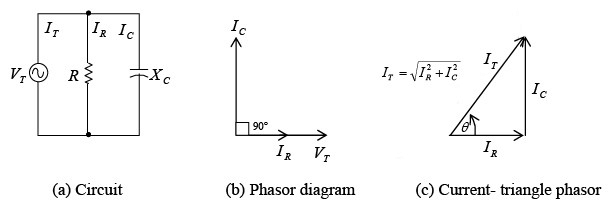 XC and R in parallel
XC and R in parallel
➤ Impedance in Parallel RC
The impedance of a parallel circuit equals the total voltage VT divided by the total current IT .
➤ Power in RC Circuits
The power formulas given previously for RL circuits are equally applicable to RC circuits.
Real power P = VI cosθ Reactive power Q = VI sinθApparent power S = VI
Reactive power Q = VI sinθApparent power S = VI
Note: Capacitance, like inductance, consumes no power. The only part of the circuit consuming power is the resistance.
Summary Table for Series and Parallel RC Circuits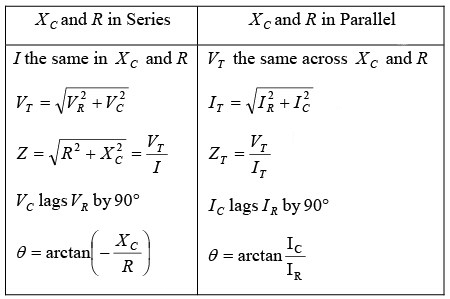
The document Capacitive Circuits | Electricity & Magnetism - Physics is a part of the Physics Course Electricity & Magnetism.
All you need of Physics at this link: Physics
|
82 videos|32 docs|22 tests
|
Related Searches
















